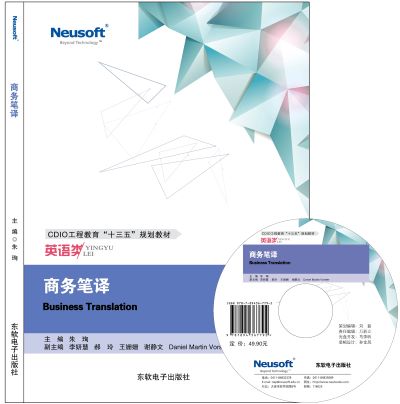Introduction of the Textbook
1. Intended Learners
This textbook has been designed for the course of Business Translation for English and Business English majors of the third year.
2. Requirements on Learners’ Knowledge
The effective use of this textbook requires learners to have certain basic knowledge of English and Business English. Basic English knowledge refers to basic English grammar, English writing and English reading skills. Business English Basic Knowledge refers to Business English Vocabulary.
3. Expected Effect of Learning
The aim of this textbook is to introduce the basic knowledge and basic skills of business translation. Learners are expected to have the ability to complete translation tasks in a business environment through the practice of real business translation cases. Ultimately, learners are expected to improve their practical ability to accurately and properly translate various business texts.
4. Textbook Compiling Team
This textbook is edited by Zhu Xun. Chapter 1 is jointly written by Zhu Xun and Li Yanhui; Chapter 2 is jointly written by Zhu Xun, Wang Shanshan and Xie Jingwen. Chapter 3 is jointly written by Zhu Xun and Hao Ling; Chapters 4 to 9 are written by Zhu Xun. In the process of the textbook compiling, Wang Shanshan has given a lot of valuable guiding advices in terms of textbook structure and compiling logic. Daniel Martin Vorster has conducted the proofreading of the whole textbook. All the authors of this textbook have master’s degrees in translation from well-known universities at home or abroad.
Part I Introduction to Business Translation
Chapter 1 Translation Fundamentals…………………………………………………3
1.1 Overview……………………………………………………………………………3
1.2 Key Points and Difficult Points………………………………………………………4
1.3 Basic Concept and Definition of Translation…………………………………………4
1.4 Translation Theories…………………………………………………………………7
1.5 Translation Techniques………………………………………………………………15
1.6 CAT Tools……………………………………………………………………………18
Chapter 2 Business Translation………………………………………………………21
2.1 Overview……………………………………………………………………………21
2.2 Key Points and Difficult Points………………………………………………………22
2.3 Target Readership of Business Documents…………………………………………22
2.4 Classification of Business Documents………………………………………………24
2.5 Translation Tasks of Different Departments…………………………………………26
2.6 Business Translation Strategies & Tactics……………………………………………28
2.7 Translator’s Non-verbal Quality Requirements………………………………………30
Part II Communication Department Translation Task
Chapter 3 Company Profile……………………………………………………………33
3.1 Overview……………………………………………………………………………33
3.2 Key Points and Difficult Points………………………………………………………34
3.3 Project Introduction…………………………………………………………………34
3.4 Input: Basic Elements of Company Profiles…………………………………………36
3.5 Case Study:E-C……………………………………………………………………40
3.6 Case Study:C-E……………………………………………………………………47
3.7 Notes on Company Profile Translation………………………………………………52
3.8 Teamwork Translation Exercises……………………………………………………53
Chapter 4 Press Release………………………………………………………………65
4.1 Overview……………………………………………………………………………65
4.2 Key Points and Difficult Points………………………………………………………66
4.3 Project Introduction…………………………………………………………………66
4.4 Input: Basic Elements of Press Releases……………………………………………68
4.5 Case Study:E-C……………………………………………………………………74
4.6 Case Study:C-E……………………………………………………………………80
4.7 Notes on Press Release Translation…………………………………………………86
4.8 Teamwork Translation Exercises……………………………………………………87
Part III Marketing Department Translation Task
Chapter 5 Product Description…………………………………………………………101
5.1 Overview……………………………………………………………………………101
5.2 Key Points and Difficult Points………………………………………………………102
5.3 Project Introduction…………………………………………………………………102
5.4 Input: Basic Elements of Product Descriptions………………………………………104
5.5 Case Study:E-C……………………………………………………………………109
5.6 Case Study:C-E……………………………………………………………………117
5.7 Notes on Product Description Translation……………………………………………123
5.8 Teamwork Translation Exercises……………………………………………………124
Chapter 6 Advertisement………………………………………………………………141
6.1 Overview……………………………………………………………………………141
6.2 Key Points and Difficult Points………………………………………………………142
6.3 Project Introduction…………………………………………………………………142
6.4 Input: Basic Elements of Advertisements……………………………………………144
6.5 Case Study:Graphic Advertising……………………………………………………148
6.6 Case Study:Audio-Visual Advertising……………………………………………153
6.7 Notes on Advertisement Translation…………………………………………………159
Part IV President Office Translation Task
Chapter 7 Annual Report………………………………………………………………163
7.1 Overview……………………………………………………………………………163
7.2 Key Points and Difficult Points………………………………………………………164
7.3 Project Introduction…………………………………………………………………164
7.4 Input: Basic Elements of Annual Reports……………………………………………166
7.5 Case Study:E-C……………………………………………………………………170
7.6 Case Study:C-E……………………………………………………………………178
7.7 Notes on Annual Report Translation…………………………………………………186
7.8 Teamwork Translation Exercises……………………………………………………187
7.9 Financial Statements Terms…………………………………………………………209
Part V Sales Department Translation Task
Chapter 8 Business Contract…………………………………………………………215
8.1 Overview……………………………………………………………………………215
8.2 Key Points and Difficult Points………………………………………………………216
8.3 Project Introduction…………………………………………………………………216
8.4 Input: Basic Elements of Business Contracts………………………………………219
8.5 Case Study……………………………………………………………………………226
8.7 Notes on Business Contract Translation……………………………………………242
Part VI Customer Service Department Translation Task
Chapter 9 Customer Service & Support Documents…………………………………245
9.1 Overview……………………………………………………………………………245
9.2 Key Points and Difficult Points………………………………………………………246
9.3 Project Introduction…………………………………………………………………246
9.4 Input: Basic Elements of Customer Service & Support Documents…………………248
9.5 Case Study:E-C……………………………………………………………………252
9.6 Case Study:C-E……………………………………………………………………258
9.7 Notes on Customer Service & Support Documents Translation……………………263
9.8 Teamwork Translation Exercises……………………………………………………264
Appendix I:The Overall Assessment Criteria…………………………………………293
Appendix II:Key Points of Knowledge and Ability……………………………………295
2016年6月,中国成为国际本科工程学位互认协议《华盛顿协议》的正式会员,这是中国工程教育国际化进程的重要里程碑。“回归工程”、培养学生的“大工程观”是当今国际工程教育的主流理念。《华盛顿协议》对毕业生提出的12条素质要求中,不仅要求工程知识、工程能力,还强调通用能力和品德伦理;在实践上,以学生为中心,以产出为导向,注重对目标达成的支撑及持续改进,与CDIO工程教育实质等效。
CDIO工程教育是近年来国际工程教育改革的最新成果,以“预期学习结果”集合来驱动课程内容、教学方法、教育文化的设计,重视营造工程教育文化,其注重工程能力培养和基于工程项目全生命周期的一体化设计思想,对于国内工程类和相关专业的建设具有重要的实施价值。
作为承载了教学改革思想的载体,融入CDIO工程教育理念的高品质教材,东软CDIO工程教育教材在注重理实结合的同时,也注重对学生八大能力的培养,即:技术知识与推理能力,开放式思维与创新,个人职业能力,沟通表达与团队合作,态度与习惯,责任,价值观,实践构思、设计、实现和运行对社会的贡献。
CDIO工程教育教材是 CDIO教育教学改革在教学实施过程中的集中体现,它不仅承载着课程和项目的教学内容,而且贯穿和体现了CDIO工程教育的理念、思想与方法,是在系统化理论的指导下,将知识、能力、素质培养进行一体化设计,有机融合在教材体系中。教材的编写以能力培养为主线,以案例教学为引导,以项目为载体,充分体现“做中学”和“学中做”的思想,具有以下优势:
(1)以能力培养为主线,培养学生专业知识学习能力和工程实践能力。
(2)以案例为驱动,在做案例的过程中学习新知识,充分体现了“做中学”。
(3)以项目为载体,基于工程化教育方法,按照分析、设计、实施、运行展开项目及知识点的讲解。
(4)围绕专业知识结构和能力体系设计教材,实现同一专业下不同教材紧密的关联性。
(5)内容编排循序渐进,符合人的认知规律。
(6)适应柔性化教学变革,构建一体化、立体化教学资源。
CDIO工程教育教材可供以应用型人才为培养目标的高等院校以及职业培训机构作为教材使用。
目前,CDIO工程教育教材的建设还处于探索阶段,是一项创造性的工作,尚需要通过改革的实践不断加以深化和持续改进,任重而道远。
